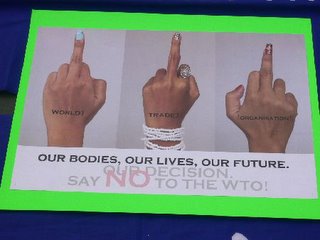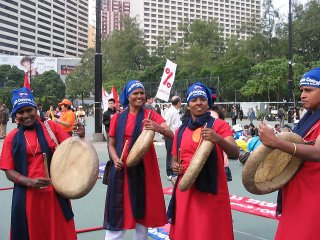White men who save brown women from brown men
Perhaps my title today is a little obscure. It is from Spivak’s “Can the Subaltern Speak?” and relates specifically to her critique of the colonial outlawing of
sati (self-immolation) and the nationalist reclamation of the practice. To spare the intricacies of Spivak’s critical thinking, I am reminded of the phrase because of what appears to be a phenomenal female presence at the WTO protests in Hong Kong and the continuing tendency of the media and politicians in the US to use ‘the freedom of women’ as a marker of success in the wars in Iraq and Afghanistan. Of course, those making the claims for the 'brown women' are white men, such as Bill O’Reilly (who isn’t a good example of a human being by any means) who used the ‘freedom of women in Afghanistan’ argument yesterday in an interview with George Galloway (admittedly, it's because of the Galloway interview that the old curmudgeon entered my mind at all). But of some concern in my opinion is also the claiming of women as a symbol for some peasant collectivities.
In this regard, I found the Guernica -like image below especially revealing. In the first instance, the USAmerican foot-soldiers for the WTO taking aim at women and children is especially evocative of the effects of globalization on women . That while policies are deeply effecting peasant communities generally in liberalizing countries, the effects of liberalization further marginalize women (regardless of their voting status) and put them at risk. However, the absence of men is unusual in a poster trying, apparently, to draw attention to the plight of farmers (in Korea, in this case). Is this a case again of women being used to signify/define a whole community?

Nationality of the soldiers aside, the image here is of aggressive men taking aim at passive women and that by destroying women, they are, in effect, destroying all peasants. I am troubled a bit by this use of women as collective signifiers. Though the motives are different, one as a form of activism, the other as a form of national braggadocio, the representation of women in this poster and the O’Reilly Factor is disturbingly similar. Both are the objects of men and symbols of the nation. For O’Reilly, having female candidates and allowing women to vote in Afghanistan is both a sign of the strength of the American nation and the ‘blossoming’ Afghani nation (will American Imperialists create better nations than British colonials?). In this poster, women are also the symbol of a collectivity (or, in the loosest sense, a nation), though this time a nation in danger, and as child-bearers. I am not noting anything new in seeing the discrepancy here between the women as symbols of a nation and the violence involved in the act of representing them as child bearers. It bodes not well for a nation.
But while in the poster women are the bearers of the nation, for O’Reilly, Afghan women again are the symbol of the nation or, more specifically, of the ‘freedom’ granted to the nation of Afghanistan by the USAmericans - USAmerican ‘heroes’ rescuing brown women from brown Taliban men...
I know I’m not connecting the dots clearly here, but hopefully my logic is visible enough. While I think that the protests are apt and prudent, I am suspicious still of the nationalist fervor with which arguments are made. "Our’ country should... " for me, words that merit suspicion...
This poster (below) is much more the line to be taken.

Of the other images I’ve found, mainly through the indymedia reporting, I was most surprised and impressed to see that a group of dalit women had come all the way to Hong Kong to protest the WTO.

Also, sex workers have made their presence felt these protests. I’m not sure what their agenda is.

 Nationality of the soldiers aside, the image here is of aggressive men taking aim at passive women and that by destroying women, they are, in effect, destroying all peasants. I am troubled a bit by this use of women as collective signifiers. Though the motives are different, one as a form of activism, the other as a form of national braggadocio, the representation of women in this poster and the O’Reilly Factor is disturbingly similar. Both are the objects of men and symbols of the nation. For O’Reilly, having female candidates and allowing women to vote in Afghanistan is both a sign of the strength of the American nation and the ‘blossoming’ Afghani nation (will American Imperialists create better nations than British colonials?). In this poster, women are also the symbol of a collectivity (or, in the loosest sense, a nation), though this time a nation in danger, and as child-bearers. I am not noting anything new in seeing the discrepancy here between the women as symbols of a nation and the violence involved in the act of representing them as child bearers. It bodes not well for a nation.
But while in the poster women are the bearers of the nation, for O’Reilly, Afghan women again are the symbol of the nation or, more specifically, of the ‘freedom’ granted to the nation of Afghanistan by the USAmericans - USAmerican ‘heroes’ rescuing brown women from brown Taliban men...
I know I’m not connecting the dots clearly here, but hopefully my logic is visible enough. While I think that the protests are apt and prudent, I am suspicious still of the nationalist fervor with which arguments are made. "Our’ country should... " for me, words that merit suspicion...
This poster (below) is much more the line to be taken.
Nationality of the soldiers aside, the image here is of aggressive men taking aim at passive women and that by destroying women, they are, in effect, destroying all peasants. I am troubled a bit by this use of women as collective signifiers. Though the motives are different, one as a form of activism, the other as a form of national braggadocio, the representation of women in this poster and the O’Reilly Factor is disturbingly similar. Both are the objects of men and symbols of the nation. For O’Reilly, having female candidates and allowing women to vote in Afghanistan is both a sign of the strength of the American nation and the ‘blossoming’ Afghani nation (will American Imperialists create better nations than British colonials?). In this poster, women are also the symbol of a collectivity (or, in the loosest sense, a nation), though this time a nation in danger, and as child-bearers. I am not noting anything new in seeing the discrepancy here between the women as symbols of a nation and the violence involved in the act of representing them as child bearers. It bodes not well for a nation.
But while in the poster women are the bearers of the nation, for O’Reilly, Afghan women again are the symbol of the nation or, more specifically, of the ‘freedom’ granted to the nation of Afghanistan by the USAmericans - USAmerican ‘heroes’ rescuing brown women from brown Taliban men...
I know I’m not connecting the dots clearly here, but hopefully my logic is visible enough. While I think that the protests are apt and prudent, I am suspicious still of the nationalist fervor with which arguments are made. "Our’ country should... " for me, words that merit suspicion...
This poster (below) is much more the line to be taken.
 Of the other images I’ve found, mainly through the indymedia reporting, I was most surprised and impressed to see that a group of dalit women had come all the way to Hong Kong to protest the WTO.
Of the other images I’ve found, mainly through the indymedia reporting, I was most surprised and impressed to see that a group of dalit women had come all the way to Hong Kong to protest the WTO.
 Also, sex workers have made their presence felt these protests. I’m not sure what their agenda is.
Also, sex workers have made their presence felt these protests. I’m not sure what their agenda is.


No comments:
Post a Comment